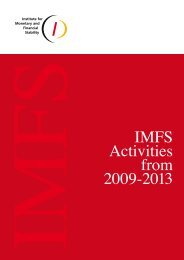ar2013
ar2013
ar2013
You also want an ePaper? Increase the reach of your titles
YUMPU automatically turns print PDFs into web optimized ePapers that Google loves.
Economic and Financial Environment<br />
Despite market concerns about the US Federal Reserve’s<br />
plan to reduce asset purchases and volatile global financial<br />
conditions, the domestic money and foreign-exchange<br />
markets continued to operate smoothly. The Hong Kong<br />
dollar exchange rate remained stable amid mild fund flow<br />
pressures. Interbank interest rates stayed low, with small<br />
fluctuations occasionally arising from temporary liquidity<br />
needs. The longer-dated yields of the Exchange Fund paper<br />
followed their US dollar counterparts to trend up slightly,<br />
ending the year with a steeper Hong Kong dollar yield curve<br />
compared with a year ago. On the credit front, growth in<br />
total loans accelerated to 16% in 2013 from 9.6% a year<br />
earlier, spurred by strong demand for trade finance and<br />
US dollar loans. However, rises in deposits and broader<br />
monetary aggregates generally lagged behind. As a result,<br />
the loan-to-deposit ratio and particularly the US dollar<br />
ratio rose further in 2013. In view of the rise in loan growth,<br />
the HKMA introduced a Stable Funding Requirement that<br />
banks with higher rates of loan growth are required to<br />
maintain a specific level of stable funds in 2014.<br />
Domestic demand<br />
Domestic demand held up in 2013 (Chart 2). On the back of<br />
still-favourable job conditions and higher incomes, private<br />
consumption grew by a solid 4.2%, similar to 2012. Growth<br />
in government consumption was steady at 2.7%. However,<br />
amid cautious business sentiment, gross domestic fixed<br />
capital formation expanded at a slower rate of 3.3%.<br />
While machinery and equipment investment maintained<br />
its growth momentum, private-sector building and<br />
construction activities continued to be a drag on overall<br />
investment growth. Public infrastructure works grew<br />
moderately after some years of strong growth.<br />
External demand<br />
Hong Kong’s total exports improved gradually in 2013.<br />
Exports of goods grew faster by 6.7%, bolstered by rising<br />
intra-regional trade (Chart 3). However, overall external<br />
demand from the advanced markets remained weak,<br />
while that from Mainland China increased at a moderating<br />
pace along with the Mainland’s slower economic growth.<br />
Underpinned by vibrant inbound tourism and a revival<br />
in stock market activities in the second half of the year,<br />
exports of services also rose at a faster pace of 5.8%.<br />
Growth in imports gathered pace on robust domestic<br />
demand and somewhat stronger export-induced demand.<br />
Overall, net exports reduced real GDP growth by 1.0<br />
percentage points in 2013. In nominal terms, the overall<br />
trade balance was a surplus of $22.3 billion (1.1% of GDP)<br />
in 2013, compared with a surplus of $23.0 billion (1.1% of<br />
GDP) in 2012.<br />
Chart 2<br />
Domestic demand<br />
20<br />
Percentage change over a year ago in real terms<br />
15<br />
10<br />
5<br />
0<br />
-5<br />
-10<br />
-15<br />
-20<br />
-25<br />
1997 1998 1999 2000 2001 2002 2003 2004 2005 2006 2007 2008 2009 2010 2011 2012 2013<br />
Private consumption Gross domestic fixed capital formation Government consumption<br />
Source: Census and Statistics Department.<br />
Page 34<br />
ANNUAL REPORT 2013 • HONG KONG MONETARY AUTHORITY



